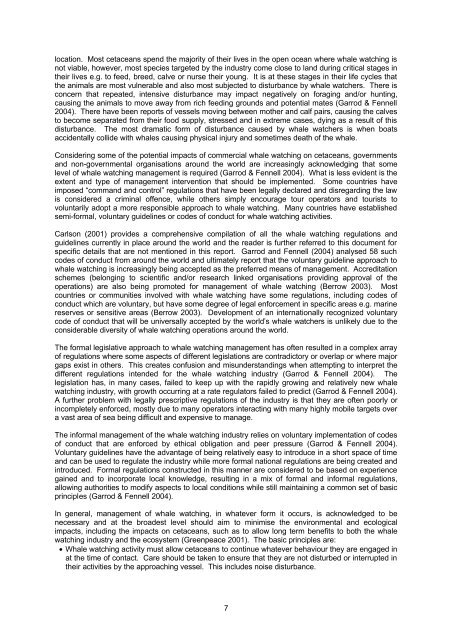Download PDF (2.5MB) - Anchor Environmental
Download PDF (2.5MB) - Anchor Environmental
Download PDF (2.5MB) - Anchor Environmental
Create successful ePaper yourself
Turn your PDF publications into a flip-book with our unique Google optimized e-Paper software.
location. Most cetaceans spend the majority of their lives in the open ocean where whale watching is<br />
not viable, however, most species targeted by the industry come close to land during critical stages in<br />
their lives e.g. to feed, breed, calve or nurse their young. It is at these stages in their life cycles that<br />
the animals are most vulnerable and also most subjected to disturbance by whale watchers. There is<br />
concern that repeated, intensive disturbance may impact negatively on foraging and/or hunting,<br />
causing the animals to move away from rich feeding grounds and potential mates (Garrod & Fennell<br />
2004). There have been reports of vessels moving between mother and calf pairs, causing the calves<br />
to become separated from their food supply, stressed and in extreme cases, dying as a result of this<br />
disturbance. The most dramatic form of disturbance caused by whale watchers is when boats<br />
accidentally collide with whales causing physical injury and sometimes death of the whale.<br />
Considering some of the potential impacts of commercial whale watching on cetaceans, governments<br />
and non-governmental organisations around the world are increasingly acknowledging that some<br />
level of whale watching management is required (Garrod & Fennell 2004). What is less evident is the<br />
extent and type of management intervention that should be implemented. Some countries have<br />
imposed “command and control” regulations that have been legally declared and disregarding the law<br />
is considered a criminal offence, while others simply encourage tour operators and tourists to<br />
voluntarily adopt a more responsible approach to whale watching. Many countries have established<br />
semi-formal, voluntary guidelines or codes of conduct for whale watching activities.<br />
Carlson (2001) provides a comprehensive compilation of all the whale watching regulations and<br />
guidelines currently in place around the world and the reader is further referred to this document for<br />
specific details that are not mentioned in this report. Garrod and Fennell (2004) analysed 58 such<br />
codes of conduct from around the world and ultimately report that the voluntary guideline approach to<br />
whale watching is increasingly being accepted as the preferred means of management. Accreditation<br />
schemes (belonging to scientific and/or research linked organisations providing approval of the<br />
operations) are also being promoted for management of whale watching (Berrow 2003). Most<br />
countries or communities involved with whale watching have some regulations, including codes of<br />
conduct which are voluntary, but have some degree of legal enforcement in specific areas e.g. marine<br />
reserves or sensitive areas (Berrow 2003). Development of an internationally recognized voluntary<br />
code of conduct that will be universally accepted by the world’s whale watchers is unlikely due to the<br />
considerable diversity of whale watching operations around the world.<br />
The formal legislative approach to whale watching management has often resulted in a complex array<br />
of regulations where some aspects of different legislations are contradictory or overlap or where major<br />
gaps exist in others. This creates confusion and misunderstandings when attempting to interpret the<br />
different regulations intended for the whale watching industry (Garrod & Fennell 2004). The<br />
legislation has, in many cases, failed to keep up with the rapidly growing and relatively new whale<br />
watching industry, with growth occurring at a rate regulators failed to predict (Garrod & Fennell 2004).<br />
A further problem with legally prescriptive regulations of the industry is that they are often poorly or<br />
incompletely enforced, mostly due to many operators interacting with many highly mobile targets over<br />
a vast area of sea being difficult and expensive to manage.<br />
The informal management of the whale watching industry relies on voluntary implementation of codes<br />
of conduct that are enforced by ethical obligation and peer pressure (Garrod & Fennell 2004).<br />
Voluntary guidelines have the advantage of being relatively easy to introduce in a short space of time<br />
and can be used to regulate the industry while more formal national regulations are being created and<br />
introduced. Formal regulations constructed in this manner are considered to be based on experience<br />
gained and to incorporate local knowledge, resulting in a mix of formal and informal regulations,<br />
allowing authorities to modify aspects to local conditions while still maintaining a common set of basic<br />
principles (Garrod & Fennell 2004).<br />
In general, management of whale watching, in whatever form it occurs, is acknowledged to be<br />
necessary and at the broadest level should aim to minimise the environmental and ecological<br />
impacts, including the impacts on cetaceans, such as to allow long term benefits to both the whale<br />
watching industry and the ecosystem (Greenpeace 2001). The basic principles are:<br />
• Whale watching activity must allow cetaceans to continue whatever behaviour they are engaged in<br />
at the time of contact. Care should be taken to ensure that they are not disturbed or interrupted in<br />
their activities by the approaching vessel. This includes noise disturbance.<br />
7
















